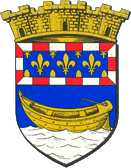
History of Saint-Valery
Saint-Valery-sur-Somme is a charming little medieval town with its marina and authentic sailor's quarter, overlooking the Bay of Somme from its three remarkable viewpoints (the Calvary, the Guillaume Gate, and the Mariners' Chapel).
Illustrious figures like William the Conqueror in 1066 have made a stop here, and Joan of Arc, held captive by the English, passed through the town in 1430.
Hut hunting and shrimp fishing still thrive, along with the rearing of salt meadow lambs. Flatfish, samphire, bisteu, ficelle picarde, and gâteau battu are among the most cherished dishes found in its numerous shops and restaurants.
Its History:
-
The origin of the town is ancient, and its history is directly linked to its geographical location. Nestled within the estuary of the Somme River, the presence of the ancient cliffs made Saint-Valery a favorable place for human habitation. Even in Prehistoric times, the site, which was once an island at high tide, was inhabited. The Greeks, starting from 700 BC, supposedly settled in Saint-Valery, then known as Leuconaus, meaning "white ship." The "heights" of Saint-Valery were occupied by the Gauls and later by the Romans.
-
In 611, the hermit monk of Irish origin Gwalaric arrived to evangelize the region, and over time, his name transformed into Walric and then Valery. He established an abbey, which became the origin of the town and the port at the current location of the quai de La Ferté. The Mariners' Chapel is situated on the site of his tomb.
-
In 859, the abbey was pillaged by the Vikings.
-
In 981, the relics of Saint-Valery, which had been purchased by the Count of Flanders in 860, were brought back to the abbey by the future king Hugues Capet. From that point forward, the place lost the name "Leuconaus" in favor of "Saint-Valery."
-
The abbey grew in importance, and a fortress was built in 1050.
-
In the 11th century, a first city wall was erected.
-
In 1066, William the Conqueror set sail for England to claim the crown promised to him by Edward the Confessor, which Harold had usurped after pledging allegiance to the Duke of Normandy. Departing from Dives-sur-Mer, he was forced to make a stop in Saint-Valery-sur-Somme due to bad weather. He left the town on September 28 and ultimately achieved victory at the Battle of Hastings on October 14, becoming the King of England and the Duke of Normandy.
-
In 1197, the town received its first charter of liberation.
-
In 1197, Richard the Lionheart captured and set fire to Saint-Valery-sur-Somme.
-
During the Hundred Years' War (1346-1453), Saint-Valery-sur-Somme was attacked and captured multiple times.
-
In August 1358, the town was besieged by the Navarrais (led by Charles the Bad, a claimant to the French crown) who had held it since 1356.
-
On April 13, 1359, the Navarrais surrendered to the troops of the regent, the future King Charles V.
-
On May 8, 1360, the County of Vimeu was ceded to the English (Treaty of Brétigny).
-
Between 1360 and 1369, the English strengthened the fortifications.
-
In 1369, following the rupture of the treaty in 1368, the French retook the County of Vimeu.
-
In December 1430, Joan of Arc, who was held captive by the English and being transported to Rouen, passed through Saint-Valery-sur-Somme.
-
From 1420 to 1433, the town was occupied by the English.
-
In 1433, the French recaptured the town but were quickly driven out themselves.
-
In 1435, the Treaty of Arras ended the civil war between the Burgundians and the Armagnacs, attributing the cities of Picardy, including Saint-Valery-sur-Somme, to the Burgundians.
-
On August 20, 1463, Louis XI bought the cities of Picardy from the Duke of Burgundy.
-
In 1467, upon the death of his father, Charles the Bold, Duke of Burgundy, questioned the loss of Picardy.
-
On July 14, 1475, Louis XI ordered the city of Saint-Valery-sur-Somme to be set on fire to prevent it from falling into the hands of the English.
-
In 1477, Louis XI took advantage of the death of Charles the Bold to reclaim Picardy and incorporate it into the Kingdom of France.
-
During the Wars of Religion (1568-1593), Saint-Valery-sur-Somme, a Catholic town, was attacked and captured multiple times, especially in 1591 and 1593.
-
In 1723, the inhabitants of the La Ferté district obtained the construction of their church, Saint-Pierre.
-
In 1786, the construction of the Somme River canal began but was interrupted by the French Revolution.
-
In 1803, Napoleon resumed the construction as he aimed to transform Saint-Valery-sur-Somme into a naval port against England.
-
In 1827, the Somme River canal was inaugurated by the King of France, Charles X. Today, it is only navigated by tourist boats.
-
The construction of the canal accelerated the silting of the bay as it eliminated the flushing effect.
-
In 1847, the Paris-Boulogne railway line was opened, with a station in Noyelles-sur-Mer.
-
In 1854, the first seawater baths were introduced. At that time, therapeutic properties were attributed to them.
-
In 1856, the Noyelles-Saint-Valery railway line was opened, contributing to the silting of the bay. In 1912, a dike was built to replace a jetty.
-
In June 1940, the German army arrived.
-
On May 23, 1944, the German occupation ended.
-
In 2011, the "Grand Site de France" label was awarded to the Bay of Somme.





